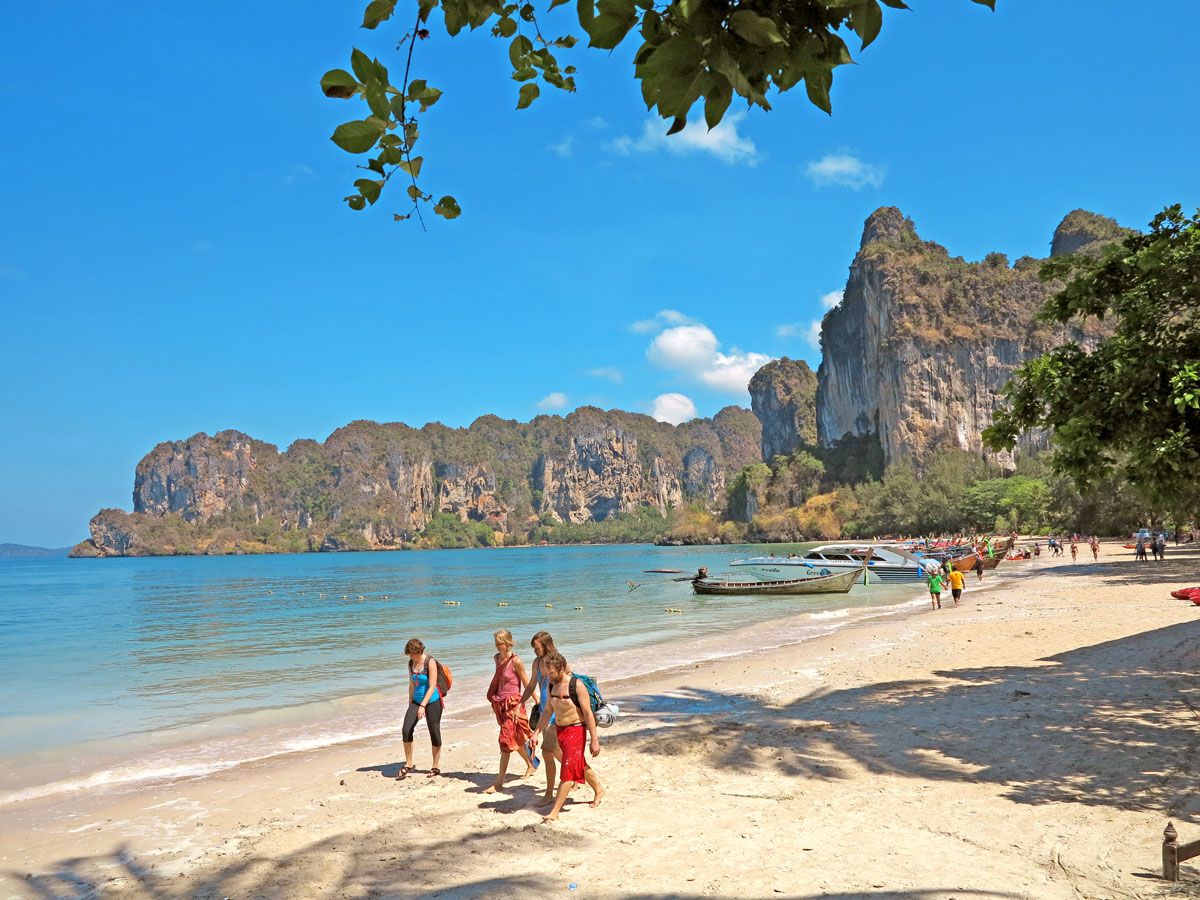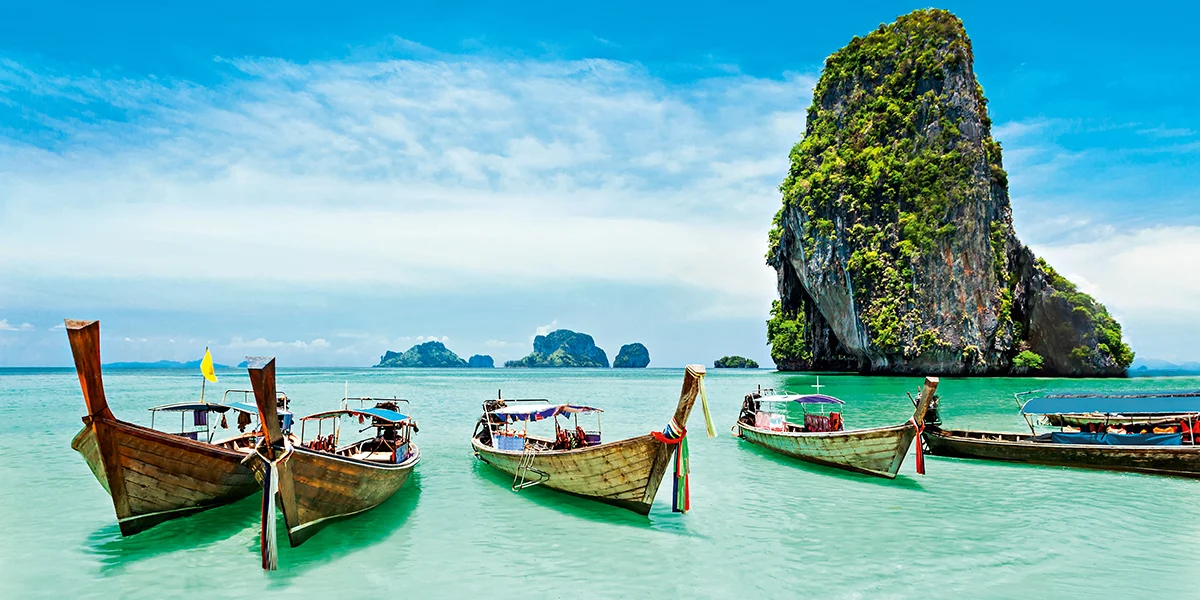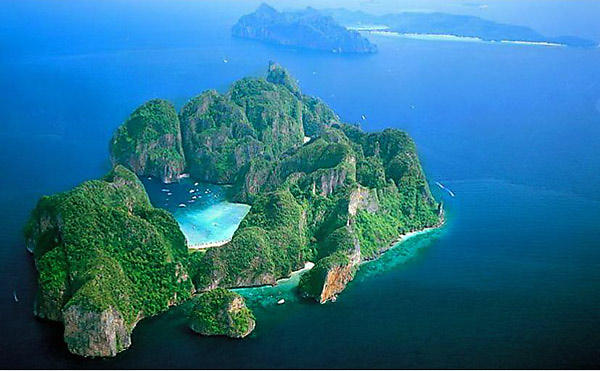-
Newsletter
Contact us:
Recent Tours
1497 Eur
From 989 Eur
Per Person
1497 Eur
From 989 Eur
Per Person
More information:
+370 615 25019
I - VI 8:00 - 22:00
Explore Thailand + relax by the sea (flight from Riga) 13 d.
13 days
Lap
Availability 15
2023.11.11-2023.11.23 from 989 Eur Purchase a tour package
1378 Eur Purchase without excursion package
Tour and shuttle package 399 Eur
Tour of Bangkok
Shuttle service during your trip
North of Thailand Excursion (2 parts)
Excursion "Pearls of the Crab"
Excursion "Phi Phi Islands" (entrance tickets paid by the travellers ~400 Thai shoes + boat and diving equipment rental - 20 €/asm)
Travel programme
1 day
- Transfer from Vilnius, Kaunas and Panevėžys to Riga Airport (extra charge).
- Arrival at Riga Airport.
- Flight Riga - Istanbul (~11:15-14:35).
- Flight Istanbul - Bangkok (~16:50-06:20*).
Day 2
- Arrive in Bangkok.
- Sightseeing tour to Bangkok.
- Transfer to the hotel.
- Check-in at a 3* hotel.
- Overnight at the hotel.
Bangkok is one of the most visited cities in Southeast Asia. It grew from a small trading village to a major city, and by the late 18th century, after the destruction of the then capital, Ayutthaya, it had assumed the role of Thailand's main city. We'll start our exploration of the Kingdom of Thailand with its main attraction, the Grand Royal Palace (entrance tickets ~ 500 Thai Baht). The palace is currently used for important ceremonies and the King of Thailand lives elsewhere. The palace complex is vast and has more than 20 buildings, among which the Emerald Buddha Temple stands out. This is the site of the most sacred relics of the Thai people. The Emerald Buddha is a dark green jade statue and is over 2 000 years old. It is considered to be an image of Thai greatness.
Next, we'll head to Wat Pho (Temple of the Reclining Buddha). There is an additional entrance fee of ~100 Thai Baht. The size of the Buddha's figure impresses every visiting traveller: the statue is 45 metres long and 15 metres high. The Buddha is covered with gold leaves. The complex also has many Buddha images, stone statues and more.
Our next destination is the Temple of the Golden Hill (additional entrance fee ~ 50 Thai baht). It was built when Ayutthaya was still the capital of Thailand. Residents claim that around 60,000 people are buried at the foot of the mountain where the temple is located. In fact, the temple was used as a crematorium when the capital was moved to Bangkok, and it is quite possible that this information is substantiated. At one time the temple was the tallest building on the eastern bank of the Chao Phraya River.
Day 3
- Check-out from the hotel.
- Excursion "North of Thailand Part I".
- We go to Erawan National Park (entrance tickets are paid by the tourists themselves ~300 Thai Baht).
- After the tour, we head to our hotel on the water.
- Check-in.
- Recreation.
- Overnight at the hotel.
The tour follows a traditional route and introduces the Thai way of life, mentality, religion, culture and history.
Boating along the canals of Damnoen Saduak village (extra cost ~ 300 baht). The village is famous for its floating market selling fruit, souvenirs, balms and much more, and you can enjoy traditional Thai dishes.
Departure to Erawan National Park (entrance fees extra ~ 300 baht).
Erawan National Park is one of the most famous natural attractions in Kanchanaburi province. There is much to see: spectacular caves, some of which have preserved old paintings on the rocks, the River Kwai, rainforests inhabited by large flying squirrels, tigers, elephants and king cobras. The park's dominant feature is a beautiful seven cascading waterfall surrounded by green jungle. The total length of the waterfall is 1.7 km. At the edge of each cascade there are pools of beautiful emerald water, where tourists love to swim. The name of the waterfall comes from the resemblance of one of its cascades to an ancient mythical animal, the Eravan, a three-headed elephant. The pools of the waterfall are inhabited by small fish called Garra Rufa, which feed on the squamous skin. At the spa, skin rejuvenation treatments with their help cost a lot of money, but here you can do it for free.
On the way, we'll stop at the radon hot baths. A short but unforgettable dip in the radon springs has a therapeutic effect on the body (additional fee ~ 60 baht).
Day 4
- Breakfast at the hotel.
- Check-out from the hotel.
- We continue with the sightseeing tour "North of Thailand Part II".
- After the tour, head to your hotel.
- Recreation.
- Overnight at the hotel.
We will have an unforgettable rafting trip on the River Kwai.
The first site we will visit on this day will be Sayok Noy Falls. It is 10 metres high and its special feature is that its waters flow directly into the River Kwai. As in the case of Erawan, you will not only be able to enjoy its aesthetic beauty, but also to swim in it.
On the way to the elephant village, we will stop at the Death Bridge. The bridge is the most famous part of the Death Road, built during the Second World War on the orders of the Emperor of Japan to allow his troops to get from Thailand to Burma, using convict and prisoner-of-war labour, and later declared a war crime.
The Elephant Village is located in the jungle among palm and mangrove trees. We'll be watching the most exciting elephant show ever: adult elephants and baby elephants dancing and throwing basketballs into a basket and climbing on stools. If you wish, you can ride the elephants (~600 shoes).
We then visit the Buddhist temple (Wat Tham Sua (Tiger Cave Temple)), which contains the mummified body of a monk and the tiger cave where he lived until his death. After 200 steps and hitting the top of the temple complex, you'll discover magical landscapes
Day 5
- Breakfast at the hotel.
- Check-out from the hotel.
- We head to Bangkok.
- Flight Bangkok - Krabi (surcharge from 80 €/person return).
- We head to the hotel.
- Check-in.
- Recreation.
- Overnight at the hotel.
Krabi is one of Thailand's provinces, located in the south of the country on the Andaman Sea coast. It is known for its beautiful sandy beaches, karst cliffs rising out of the water, picturesque tropical islands, rainforests and numerous caves.
Day 6
- Breakfast at the hotel.
- Free day.
- Recreation.
- Overnight at the hotel.
Day 7
- Breakfast at the hotel.
- Excursion "Pearls of the Crab".
- After the tour, head to your hotel.
- Recreation.
- Overnight at the hotel.
At the beginning of the day we will visit the Tiger Rock Temple, one of the most famous attractions in Krabi province. The temple gets its name from the 270 metre long rock that resembles the claw of a tiger. The temple has many statues of Buddha and tigers, and one of the small cave spaces contains the footprint of Buddha. However, most tourists come here not only for the temple, but also for the 'purification trail' next to it. This trail stretches from the foot of the mountain to the top, at an altitude of 600 metres. To climb the Buddha statue hill, 1 237 steps must be climbed, taking an unprepared person 30-40 minutes. Once you reach the top, you have a magnificent panoramic view of almost the entire province of Kraba.
Later, we will go to the hot springs (extra charge).
The springs contain minerals that are good for the human body, and the water has different temperatures (from 28 to 45 degrees Celsius). Swimming in these waters relieves stress, replenishes positive energy and refreshes you after the strenuous climb up the Tiger Temple.
The last stop on this itinerary is a visit to Emerald Lake (extra cost for tickets). The lake is located in a picturesque area with small wooden bridges. At the entrance to the complex, the first object we will see is another lake, Crystal. Looking at it, it seems that rainforests grow from the very bottom. Emerald Lake is of artificial origin, dug out of the rock by the local population in the path of the river flow. The reservoir is filled with mineral-rich water, which gives it a beautiful emerald hue. Few people can resist the urge to swim in it.
Day 8
- Breakfast at the hotel.
- Excursion "Phi-Phi Islands" (entrance tickets paid by tourists ~400 Thai baht + boat and diving equipment rental - 20 €/person).
- After the tour, head to your hotel.
- Recreation.
- Overnight at the hotel.
This sightseeing programme is considered one of the favourites of tourists travelling around the Thai territory. We will see Maya Bay, famous for the filming of scenes from the famous movie "The Beach" starring Leonardo di Caprio. We will visit the Viking Cave, a picturesque place that has become home to the swallow. On the way to the next island, we will stop so that everyone can swim and enjoy the rich underwater world of the Andaman Sea.
The next stop will be Pile or the "revitalisation" lagoon. Legend has it that bathing there has a rejuvenating effect. The lagoon is hidden from the eyes of passing fishermen and tourists, and you have to wade through jungle and rocks to reach it.
The final stop will be at Bamboo Island - palm trees, snow-white beach, blue water. This island is also known as Bounty Island in popular advertising.
Day 9
- Breakfast at the hotel.
- It's boat time at sea.
- For those who wish, we offer a 2-day sightseeing tour to "Phang Nga Province and Khao Sok National Park" - extra charge (entrance tickets are extra).
- Settling in a hotel/bungalow on the water (only for those who went on the trip).
- Recreation.
- Overnight at the hotel.
Departure to Khao Sok National Park.
Khao Sok National Park, in Phang Nga province, covers an area of 750 km² of impenetrable jungle, limestone cliffs and karst caves. This vast area of natural resources is home to a wide variety of animals and plants.
The jewel of the park is Cheo Lan Lake, located in the very centre of the park. The lake's limestone coffins rise spectacularly above the water's surface, some of them reaching heights of several hundred metres. They form stunning silhouettes against each other, with mist blending their rocky peaks against the emerald green water. A trip on the lake will also give you the unique experience of staying overnight in the floating bungalows of Khao Sok.
During the tour, we will take a boat ride, visit one of the caves and several temples, and admire the magnificent view from the Ratchamprapa Dam.
Day 10
- Breakfast at the hotel.
- It's boat time at sea.
- Check-out from the hotel (only for those who went on a trip).
- We continue our sightseeing excursion to "Phang Nga Province and Khao Sok National Park" - extra charge (entrance tickets are extra).
- We return to Krabi (only those who went on the trip).
- Recreation.
- Overnight at the hotel.
Depart for Wat Suwan Kuha (Monkey Temple) (~ 20 baht).
The present temple is a place of worship for local Buddhists. The largest of the four caves, the underground Tham Yai, contains several standing and seated Buddha figures and many religious statues. The main attraction of the temple is a 15-metre Buddha statue made in the traditional Thai art style. The caves of the temple complex are decorated with stalactites and stalagmites and are home to bat and bird colonies. And thanks to its location on a hill, the cave's summit offers a breathtaking view of the surrounding countryside.
We go to Pung Chang Cave (elephant's stomach) (~ 100 baht, boat rental extra).
A cave with various stalagmites and stalactites and a year-round underwater river. We will explore the dark cave by boat, as some parts of it are flooded.
At the end of the programme, we will stop and visit the hot springs of Khao Phanom Bench National Park. The park is a popular destination for its waterfalls, caves and trails through the montane forests (~100 baht).
Day 11
- Breakfast at the hotel.
- Free time or we offer a sightseeing boat trip to Hong Island - 45 €/person (entrance tickets are paid by the tourists ~400 Thai Baht).
- We return to the hotel.
- Recreation.
- Overnight at the hotel.
Visit the beautiful Pak Bia and Lao Lading islets, surrounded by stunning lagoons with crystal clear water. We will stop for surface diving and beach relaxation. Admire vertical limestone cliffs, lush green jungles, white beaches and turquoise lagoons.
The road continues to Hong Krabi Island. Like its neighbour Phi Phi, Hong Krabi Island has also appeared on TV, where the film 'The Jungle' was shot.
Finally, we will visit the beach with the romantic name "Paradise".
Day 12
- Breakfast at the hotel.
- Check-out from the hotel.
- We head back to Bangkok.
- Flight Crabby - Bangkok (extra charge from €80/person return).
- Transfer to the hotel.
- Check-in.
- Overnight at the hotel.
Day 13
- Early morning transfer to the airport.
- Flight Bangkok - Istanbul (~07:50-13:55).
- Depart for Istanbul.
- Flight Istanbul - Riga (~16:10-19:25).
- Arrival at Riga Airport.
- Transfer from Riga Airport to Vilnius, Kaunas and Panevėžys.
Included in the price
INCLUDED IN THE TRIP PRICE
Riga - Bangkok - Riga with change in Istanbul (Turkish Airlines)
Hand luggage up to 8 kg (dimensions: 56x45x25 cm)
Checked baggage up to 23 kg
11 nights in hotels (double rooms)
10 breakfasts in hotels
Tour manager services
Arranging travel documents
ADDITIONAL EXCURSIONS (PAYABLE AT THE TIME OF TRAVEL)
Sightseeing tour to "Phang Nga Province and Khao Sok National Park" (2 parts), additional entrance fees ~ 300 Thai Baht - from 50€
Excursion boat trip to Hong Island (island is part of the national park, entrance fees extra ~ 400 baht) 45€
ADDITIONALLY AVAILABLE FOR PURCHASE
Domestic flight Bangkok - Krabi - Bangkok (checked baggage up to 15 kg + hand luggage up to 7 kg) €80
If you are travelling alone, there will be an additional charge of €150 per room
BY OFFENSE
Transfer from Vilnius/Kaunas/Panevėžys to Riga Airport and back (ON DEMAND)
EXTRA CHARGE
Passenger tax (ATTA and IATA association fee) ~ 5 €/person
PAID AT THE TIME OF TRAVEL
Entrance tickets to attractions.
In Thailand, it is customary to thank drivers and guides with a tip of around 15 $/asm./trip
IMPORTANT INFORMATION
The tour leader (who accompanies you throughout the trip) and the guide provide information in Russian!
Please check the "Departures" section of our website 1-2 days before the start of your trip for the exact departure time and location
The tour leader can change the course of the programme
The tour is organised on scheduled flights, so the organiser may cancel the booking or offer a surcharge due to the cost of air tickets. If the traveller does not accept the surcharge, the money will be refunded.
Whether or not you have free time depends on the absence of unforeseen situations, traffic congestion and other deviations from your schedule
"Ryanair and Wizz Air do not seat passengers next to each other for free. There is a charge for this service, please ask your manager for the cost of this service
-
DepartureRiga
-
Included
-
Not Included
Similar Tours

nuo 2028 Eur
Pažintinė-poilsinė kelionė į Filipinus. Sniego baltumo Malajų salyno salos (skrydis iš Rygos).
Filipinai yra archipelagas arba daugiau nei 7100 salų virtinė pietryčių Azijoje tarp Pietų Kinijos jūros ir Ramiojo vandenyno. Dvi didžiausios salos – Luzonas ir Mindanao – sudaro du trečdalius viso žemės ploto. Tik apie trečdalis salų yra apgyvendintos.
ŽMONĖS IR KULTŪRA
Filipiniečiai daugiausia yra kilę iš malajiečių, dažnai turi kinų, o kartais ir amerikiečių ar ispanų protėvius.
ŽMONĖS
Daugelis filipiniečių turi ispaniškus vardus dėl XIX amžiaus Ispanijos dekreto, pagal kurį buvo reikalaujama naudoti ispaniškas pavardes arba pavardes. Tėvai dažnai savo vaikus pavadina šventojo vardu, kurio šventė buvo jų gimimo dieną.
Pradinis mokslas Filipinuose prasideda nuo septynerių metų, yra privalomas pagal įstatymus ir trunka šešerius metus. Vidurinis ugdymas pradedamas sulaukus 13 metų ir trunka ketverius metus; bakalauro koledžo mokymas paprastai trunka ketverius metus.
GAMTA
Salose auga daugybė žydinčių augalų ir paparčių rūšių, įskaitant šimtus orchidėjų rūšių. Aukštos žolės pakeitė miškus, kurie išnyko dėl medienos ruošos, kasybos ir plėtros.
Filipinuose gyvena daugiau nei 200 žinduolių rūšių , įskaitant beždžiones, voveres, lemūras, peles, pangolinus, chevrotains, mangustus, civetas kates, raudonuosius ir ruduosius elnius ir kt.
Binurongas arba Azijos lokio katė kažkada buvo žinoma, tačiau dabar šis pūkuotas žinduolis yra pažeidžiamas. Tamaraw, mažų vandens buivolių rūšis, aptinkama tik Mindoro saloje, yra labai nykstanti.
Filipinuose visus ar dalį metų gyvena šimtai paukščių rūšių, įskaitant povus, fazanus, balandžius, papūgas, karališkąsias žuveles, saulės paukščius, siuvinius, audinius ir raguočius. Nykstantis Filipinų erelis, mintantis beždžionėmis, vos išgyvena po miškų kirtimo.
ISTORIJA
Ferdinandas Magelanas pirmą kartą nusileido Filipinuose 1521 m. Filipinų pavadinimas kilęs iš Pilypo II, kuris buvo Ispanijos karalius XVI amžiuje, kai šalis tapo Ispanijos kolonija.
Filipinai buvo suteikti Jungtinėms Valstijoms 1898 m., Po Ispanijos ir Amerikos karo. 1935 m. Filipinai tapo savarankiški, tačiau jų nepriklausomybę atidėjo Antrasis pasaulinis karas ir Japonijos kariuomenės invazija.
Salas išlaisvino JAV pajėgos 1944–1945 m., o Filipinų Respublika buvo paskelbta 1946 m., vyriausybei vadovaujant JAV.
1965 metais Ferdinandas Marcosas buvo išrinktas prezidentu. 1972 m. jis paskelbė karo padėtį, kuri tęsėsi iki 1981 m. Po 20 valdymo metų 1986 m. Marcosas buvo nuverstas nuo valdžios. Corazon Aquino tapo prezidentu ir šalyje įvedė demokratinio valdymo laikotarpį.
14 days

from 699 Eur
Izraeilis, pažintinė kelionė į šventąją žemę (skrydis iš Vilniaus).
Israel is the country where the events in the Bible took place.
8 days

From €769
Lucy 5*, Graikija- Kavala.
This mainland hotel is next to the sea, a few steps from a Blue Flag-certified sandy beach with free service.
Turtingos, senovę menančios istorijos regionas Graikijos šiaurės rytuose. Čia susikerta trijų kultūrų įtaka: graikiškos, romėniškos ir bizantiškos. Paplūdimiai išsiskirti Mėlynąja vėliava, puikios sąlygos pramoginei laivybai, gausybė lankytinų vietų.
7 days





















































